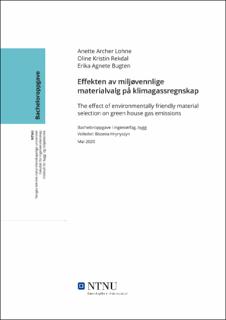| dc.contributor.advisor | Hrynyszyn, Bozena | |
| dc.contributor.advisor | Andersen, Ingunn Tøvik | |
| dc.contributor.author | Lohne, Anette Archer | |
| dc.contributor.author | Rekdal, Oline Kristin | |
| dc.contributor.author | Bugten, Erika Agnete | |
| dc.date.accessioned | 2020-06-30T16:01:13Z | |
| dc.date.available | 2020-06-30T16:01:13Z | |
| dc.date.issued | 2020 | |
| dc.identifier.uri | https://hdl.handle.net/11250/2660150 | |
| dc.description.abstract | Menneskeskapte klimagassutslipp har ført til at verden står ovenfor store klimautfordringer. Byggebransjen er i dag ansvarlig for 39 % disse utslippene og bruker klimagassregnskap som et virkemiddel i et forsøk på å redusere utslippene. Klimagassregnskapene viser tydelig hvilke elementer som fører til de største utslippene i et bygg og gjør det lettere å finne hvilke tiltak som har størst effekt. Denne oppgaven tar for seg hvilken effekt miljøvennlige materialvalg har på et klimagassregnskap. Det er undersøkt ved å utføre en klimagassberegning av Huseby skoler.
Klimagassberegningen viser at den prosjekterte skolen har svært lave klimagassutslipp, og at dette i stor grad er grunnet miljøvennlige materialvalg. Selv små endringer i materialer har en effekt. Derfor legges det frem ulike scenarioer som ytterligere reduserer utslippene, der det beste scenarioet viser en reduksjon av CO2-ekvivalenter på 7 %. Oppgaven belyser samtidig eventuelle svakheter ved ulike materialvalg, og peker ut tre som et materiale med lave utslipp. Videre understreker den også viktigheten av lokale materialvalg, da transportavstand gir store utslag i regnskapet. Det kreves en detaljprosjektering for å avdekke nødvendige tekniske løsninger som oppfyller ulike byggtekniske krav, og uten dette kan det ikke fastslås at det beste scenarioet vil prestere bedre enn prosjektert bygg. Til tross for dette, viser scenarioene fortsatt reelle tiltak som bør vurderes og som vil redusere utslippene ytterligere. | |
| dc.description.abstract | The world is facing significant challenges due to greenhouse gas emissions caused by human activities. The construction industry is currently responsible for 39% of these emissions and is utilizing greenhouse gas calculation to reduce the emission and mitigate these challenges. The calculations can help identify which elements in a building that contribute to most emissions and make it easier to find which measures can be taken to best help reduce these. The aim of this thesis is to examine the effect of environmentally friendly material selection on greenhouse gas emissions. This is done by performing a greenhouse gas calculation of “Huseby skoler”.
The calculations show that it already performs very well, and that this is mostly due to environmentally friendly material selection. Because even small exchanges of materials can have an effect on the results, this thesis presents different scenarios that further reduces the greenhouse gas emissions. The results show that the best performing scenario reduces CO2-equivalents by 7 %. This thesis also sheds light on potential weaknesses in various choices of materials and identifies wood as a material with low emissions. Furthermore, it highlights the importance of locally sourced materials, because transportation distance largely impacts the results. It would require a detailed planning to uncover technical solutions necessary to meet various building requirements. Without this, it cannot be presumed that the best scenario will perform better than the school is already doing, however, the scenarios still show substantial measures that should be considered because they can potentially further reduce emissions. | |
| dc.publisher | NTNU | |
| dc.title | Effekten av miljøvennlige materialvalg på klimagassregnskap | |
| dc.type | Bachelor thesis | |
